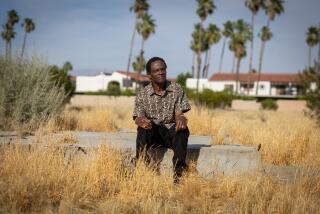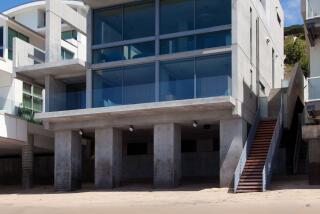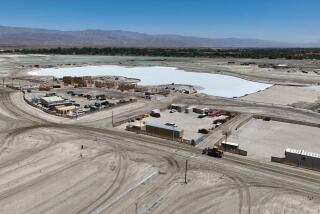A Problem Preserved : Rancho Proposal Would Trade Old Plaster for Older Adobe
The courtyard at Rancho Los Cerritos in Long Beach is a pleasant place to while away a summer afternoon.
Covered by neatly trimmed grass, the 120-by-60-foot yard contains palm trees, orange trees and a bird of paradise plant. Near its center, a quiet reflecting pond plays host to a family of goldfish. And leading to a large glassed sun patio at one end, the seemingly endless white plastered walls bespeak the casual elegance of a bygone era.
Within those walls, however, lurks a potential danger that could result in the radical alteration of everything familiar the courtyard holds.
The culprit is moisture. Unable to escape through the plastered cement that coats the facility’s original adobe walls, engineers say, water is literally being sucked up from the ground into the interior wall, causing severe deterioration that has already resulted in visible cracks and major crumbling. Unless something is done, the engineers say, the ranch house--built in 1844 and designated as a national, state and local historical landmark--may become a structural hazard.
To solve the problem, employees of the city, which has owned and administered the site since 1956, have devised a drastic plan. Remove the exterior plaster cement so that the adobe can breathe, they say. And, in the process, make dramatic structural changes that would return the rancho to its original historical condition circa 1870 when it was a thriving sheep ranch with primitive dirt floors and flat tar roofs.
Early Type of Construction
The changes also would greatly enhance the rancho’s educational value and visitor appeal, they argue. Because the project would rely on earlier, simpler forms of construction, they say, it would cost less than preserving the site as it now exists.
But it would also virtually undo a major 1931 renovation performed by the Bixby family, the site’s former owners whose history is inexorably tied to that of the city and the rancho. That renovation preserved the facility for posterity, transforming Rancho Los Cerritos from a dilapidated ranch house to the elegant 1930s mission revival style of home that visitors now see. And the specter of reversing it has raised eyebrows.
“I don’t think it’s appropriate,” said Llewellyn Bixby, 81, who remembers living in the house as a young man during the period that his father--also named Llewellyn--performed the needed alterations. “Dad would probably be very disturbed.”
Said Louis Skelton, a local architect and member of the city’s Cultural Heritage Commission, which earlier this month heard an informal presentation on the plan: “I have (serious) reservations about removing something that has been here for more than 50 years and has become a recognized part of the community. Based on what I know right now, I would be reluctant to vote for it.”
The deep feelings for the rancho stem from its history.
Located in the Bixby Knolls area of Long Beach, the 4.7-acre site was originally part of a 300,000-acre land grant awarded by the Spanish government to Manuel Nieto in the late 1700s as a reward for his military service. After years of joint ownership by his children, the lands were eventually divided into six parcels, one of which was Rancho Los Cerritos bordered on the west by what is now the Los Angeles River and on the south by the Pacific Ocean.
In 1843 a Massachusetts-born businessman named John Temple purchased the site and the next year constructed the present adobe house as headquarters for his large-scale cattle operations. By 1866, however, successive years of drought and flood had put a severe dent in the cattle business, prompting Temple to sell the ranch to a firm called Flint, Bixby & Co. which was in the business of raising sheep.
That company sent Jotham Bixby, the brother of one of its founders, to manage the new ranch. Eventually the young manager bought into the property, formed his own company, and from 1866 to 1881 resided with his wife and seven children in the old Temple adobe.
Portions Were Sold
By the late 1870s, with the sheep industry declining, Bixby began leasing or selling off portions of the estate. Four thousand acres in the southwest corner were purchased by William Willmore in 1881. Willmore lost his option on the acreage and was forced to give up his contract in 1884 to the Long Beach Land and Water Co., which renamed the area Long Beach. Downtown Long Beach now occupies the acreage.
Other parcels evolved into the cities of Downey, Paramount and Lakewood.
The adobe itself fell into disrepair for many years after Jotham Bixby’s departure. Then in 1929 his nephew, Llewellyn Bixby, purchased the property and began the extensive renovations that included the plaster cement coating, a new red-tiled roof, expanded rooms, electricity, plumbing, fireplaces, the sun porch, new floors and much of the landscaping. After living in the house until the late 1940s, the Bixby family sold it to the city, which turned it into a museum dedicated to educating the public regarding the ranching period of pre-Long Beach history.
That mission could be better served, according to Ellen Calomiris, who manages the site for the city, by returning the old ranch house to its 1870s design. “We’re misleading the public,” she said, referring to the estimated 15,000 visitors--including about 3,000 elementary school pupils--who tour the site each year. “What we can tell with (the house) now is the life of a well-to-do family in the 1930s with its maids and chauffeurs. What we want to tell is the story of economic and domestic life in the 1870s.”
Transition Period
That period is of particular significance in California history, she said, because it represents the transition from early ranch life to the creation of cities and towns. And while the region is rife with other good examples of 1930s-style mission revival architecture, she said, the proposed renovation would result in the only restored 1870s ranch house in Southern California.
“We feel that the appeal would be much broader,” Calomiris said. “Although the Bixby family has always had a major role in the development of the city, this house didn’t (after the late 1800s).”
But the city’s approach has raised the hackles of some historic preservationists who are bothered by the philosophical implications of focusing on one particular period of a building’s history to the physical detriment of all its other periods.
In a letter to Calomiris earlier this month, in fact, David W. Look, chief of the Preservation Assistance Branch of the U.S. Department of the Interior which has given Rancho Los Cerritos national historic landmark status, expressed the department’s staunch opposition to the proposed changes.
Removal of 1931 Changes
“We understand that your purpose is to interpret the 1860s-1880s period of the rancho,” Look wrote, “and that the current 1930s appearance of the building and grounds makes interpretation of the earlier period difficult. However, the proposed restoration would result in the removal of all of the 1931 changes to the property, which are now historic and appear to have gained significance in their own right.”
Removal of the 1931 alterations, Look went on, would violate several Department of Interior standards which “encourage recognition and respect for changes that have taken place over time, and discourage the removal or alteration of historic fabric.”
Besides removal of the cement plaster now coating the adobe, the proposal calls for replacing the red tiled roof with a flat tar roof in some places and a pitched shingle roof in others; removing much of the interior cement and wood floors in favor of packed dirt floors; getting rid of the glassed-in patio and reflecting pond; and replacing the grass and most of the landscaping in the courtyard with coarse sand.
In addition, the project would convert existing rooms back to their original uses and add at least six interior walls that were removed in 1931. Those familiar with the proposal estimate its cost at about $5 million.
Interior Strengthening
Even if the proposal is eventually rejected, engineers say, the structure at a minimum would have to be preserved by replacing the cement coating with sand plaster, removing the cement work and brick pathways adjacent to exterior adobe walls, removing the concrete slabs under the building’s flooring, and installing an underground drainage system. The building’s roof would also have to be removed so that existing beams could be strengthened and interior cross walls reconstructed to meet local earthquake standards, the experts say. This rehabilitation would cost even more than the proposal to convert the rancho to its original status, they say.
City officials say they expect the matter to come before the Cultural Heritage Commission for a formal vote in October. Following that, they say, it would have to be approved by the city’s Planning Commission and, finally, the full City Council.
“We’re (moving) very cautiously,” said Ruthann Lehrer, the city’s historic preservation officer, adding that her own mind is not yet made up on the matter. “Los Cerritos is a very important site with a unique place in the history of Long Beach. We want to be very wise and careful because (what we decide) will set the stage for the future of the site, which we hope will go on for many hundreds of years.”
More to Read
Sign up for Essential California
The most important California stories and recommendations in your inbox every morning.
You may occasionally receive promotional content from the Los Angeles Times.










